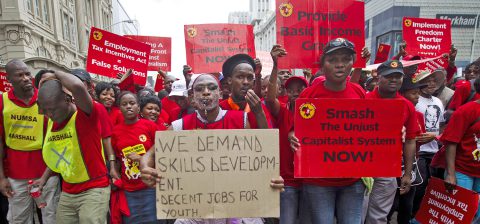Infrastructure
On The Rise: A New Breed Of Construction Companies
The next few years will certainly be interesting.
Infrastructure recently caught up with the CEOs of mid-tier firms operating in the construction sector – Donald Platt of Accentuate’s flooring division FloorworX, Afrimat’s Andries van Heerden and Calgro M3’s Wikus Lategan – to unpack the drivers transforming the sector over the next few years.
“The break-up of oligopolies is never a bad thing as it opens up the playing field to new players and leads to the rise of smaller players. However, on the flipside, big companies that traditionally handled large-scale projects are disappearing. There is definitely going to be a shift in the long term, especially in line with the incremental growth that we are noting,” says Platt.
He notes also that there is already an infiltration of international players, including Chinese and European (French) construction companies, entering the fray.
“Existing mid-tier construction companies will begin to play a more significant role, as will a greater number of smaller and medium-sized BEE construction companies,” says Van Heerden. He believes the recovery of the economy will see the emergence of a new set of “top five” construction companies.
This new breed of construction companies will be extremely efficient and complement their executing abilities with strong strategic capabilities, he says.
“It is sad and alarming to see businesses that were built from nothing being brought to their knees so easily. It has, however, been a serious wake-up call for us to make sure that our businesses are well diversified and able to withstand black swan events,” says Calgro M3’s Lategan.
According to Lategan, the assumption is that the necessary upgrades to the water, roads and electrical infrastructure will be awarded to local construction companies, which will use local labour, thereby creating job opportunities.
A tough operating environment and government’s poor infrastructure spend are cited as key contributors to the construction industry’s ruin, which includes, among others, Basil Read, Group Five, Liviero Group and Esor Construction.
Added to this, the failure to address the challenges faced by the sector is expected to hamper South Africa from achieving its growth targets.
Respondents have also warned that elements such as appropriately costing projects and factoring in currency fluctuations could negatively impact the sector going forward.
“Currency fluctuations continue to negatively impact the construction sector, particularly a weakening rand, which makes it difficult to price projects correctly,” says Platt.
Materials supplier to construction companies, Afrimat, notes that the companies identified as being successful are “those that are efficient at project execution, adopt innovative and scientifically sound techniques to keep their costs down and prevent costly mistakes. In short, they ensure that they have properly skilled people”.
To ensure growth of the industry over the long term, government, apart from sending out a clear and positive message encouraging foreign investors to invest in the country, needs to provide clarity on the issues associated with land distribution – a sore point that is “frightening investors away”.
“Investors want a stable environment and to see a return on their investments. As such, we need to create an environment which delivers a return on investment – and one which promises ease of conducting business and a climate that builds confidence,” says Platt.
To this, Van Heerden adds that the “political agenda must be aligned to eradicating corruption and restoring confidence”.
“Crime should be a top priority, especially the gangsterism that often disrupts construction projects. Sanral and the Department of Human Settlements also have a significant role to play in ensuring a proper pipeline of projects is planned for roll-outs.”
A few green shoots
Early signs of the construction industry recovery have been noted, with the sector “starting to see spurts of growth even if it’s from a low base”.
“Afrimat sees very good opportunities in the mining space and our entry into industrial minerals and more recently iron ore is delivering fantastic results for us. Our construction materials cluster remains a good business and we see opportunities in other African countries where large projects are under way. The risk profile in many African countries is different to that of South Africa and must be taken into account.”
On the back of the massive backlog in the healthcare sector, Accentuate believes that discussions on the NHI could trigger growth in line with the refurbishment of existing hospitals and clinics as well as the development of more new schools. The affordable housing market backlog holds promise for the construction sector.
“Furthermore, with the uptick in the economy, there continue to be developments in the corporate space, especially in key areas such as Sandton, Cape Town and Umhlanga in KwaZulu-Natal.”
However, following the excessive investment already ploughed into the development of shopping centres, Platt expects to see a downturn in the shopping centre market, which has reached saturation point. The strength of online shopping has also contributed to the slowdown in shopping centre development, he says.
Given the backlog in affordable housing, Lategan expects the housing market to continue to be a lucrative sector attracting investment in the market.
“With an estimated population of 58 million people, equating to 16.5 million households and only 6.5 million registered residences, it is estimated that South Africa’s housing backlog stands at a staggering 10 million units. Calgro M3’s current pipeline only caters for 55 000 of this 10 million – a mere drop in the ocean. Due to the dire need for dignified housing, Calgro M3 believes it is well placed to capitalise on the housing backlog. Our experience in the market and our turnkey business model have created enough value to not only withstand the challenges but also to make an acceptable return for our stakeholders,” says Lategan.
Projects under way
FloorworX is focused on hospitals, clinics and schools.
Afrimat, which is involved in a village resettlement project in Mozambique, remains focused on growing its mining portfolio.
Private housing sector-focused Calgro M3 is busy developing 10 housing projects, including infrastructure work on its Belhar project which offers in excess of 8 000 serviced opportunities.







 Sign-up and receive the Business Media MAGS newsletter OR SA Mining newsletter straight to your inbox.
Sign-up and receive the Business Media MAGS newsletter OR SA Mining newsletter straight to your inbox.